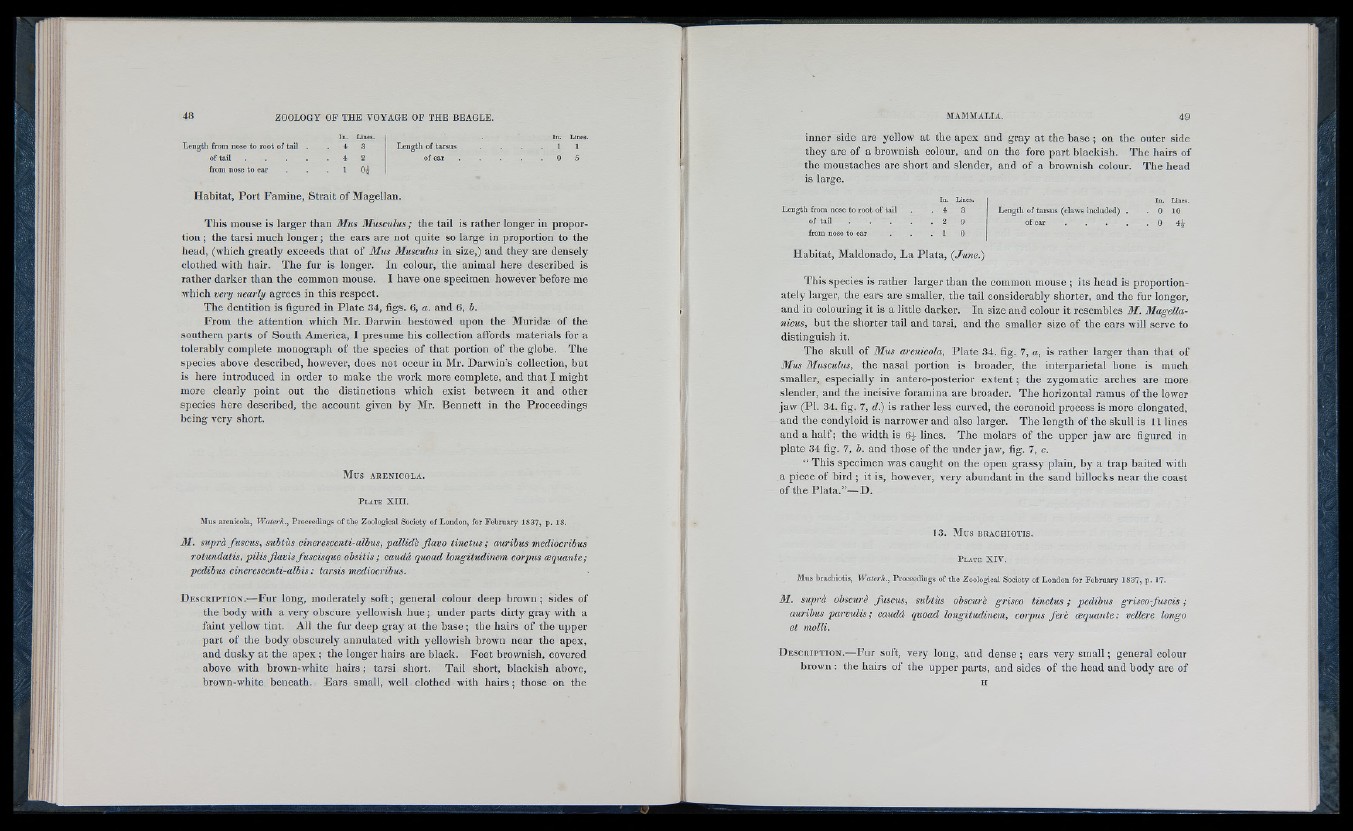
Length from nose to toot of tail
of tail .
from nose to ear
In. Lines.
4 3
4 2
1 04
Length of tarsus
of ear
In. Lines.
1 1
0 5
Habitat, Port Famine, Strait of Magellan.
This mouse is larger than 3Ius 3Iusculus; the tail is rather longer in proportion
; the tarsi much longer; the ears are not quite so large in proportion to the
head, (which greatly exceeds that of 3Ius Musculus in size,) and they are densely
clothed with hair. The fur is longer. In colour, the animal here described is
rather darker than the common mouse. I have one specimen however before me
which very nearly agrees in this respect.
The dentition is figured in Plate 34, figs. 6, a. and 6, b.
From the attention wliich Mr. Darwin bestowed upon the Muridse of the
southern parts of South America, I presume his collection affords materials for a
tolerably complete monograph of the species of that portion of the globe. The
species above described, however, does not occur in Mr. Darwin’s collection, but
is here introduced in order to make the work more complete, and that I might
more clearly point out the distinctions -which exist between it and other
species here described, the account given by Mr. Bennett in the Proceedings
being very short.
Mus ARENICOLA.
P late X III.
5Ius arenicola, Waterh., Proceedings of the Zoological Society of London, for February 1837, p. 18.
31. suprà fuscus, subtùs cinerescenti-albus, pallidè flavo tinctus ; auribus mediocribus
rotundatis, pilis fiavis fuscisque obsitis ; caudâ quoad longitudinem corpus cequante;
pedibus cinerescenti-albis : tarsis mediocrihus.
D e s c r ip t io n .—-Fur long, moderately soft ; general colour deep brown; sides of
the body with a very obscure yellowish hue ; under parts dirty gray with a
faint yellow tint. All the fur deep gray at the base ; the hairs of the upper
part of the body obscurely annulated with yellowish brown near the apex,
and dusky at the apex ; the longer hairs are black. Feet brownish, covered
above with brown-white hairs ; tarsi short. Tail short, blackish above,
brown-white beneath. Ears small, well clothed with hairs ; those on the
inner side are yellow at the apex and gray at the base ; on the outer side
they are of a brownish colour, and on the fore part blackish. The hairs of
the moustaches are short and slender, and of a brownish colour. The head
is large.
Length from nose to root of tail
of tail
from nose to eat
In. Lines.
4 8
2 9 Length of tarsus (claws included)
of ear . . . 0 44
Habitat, Maldonado, La Plata, (June.)
This species is rather larger than the common mouse ; its head is proportionately
larger, the ears are smaller, the tail considerably shorter, and the fur longer,
and in colouring it is a little darker. In size and colour it resembles 31. Magella-
7iicus, but the shorter tail and tarsi, and the smaller size of the ears will serve to
distinguish it.
The skull of Mus arenicola, Plate 34. fig. 7, a, is rather larger than that of
Mus Musculus, the nasal portion is broader, the interparietal bone is much
smaller, especially in antero-posterior extent; the zygomatic arches are more
slender, and the incisive foramina are broader. The horizontal ramus of the lower
jaw (PI. 34. fig. 7, d.) is rather less curved, the coronoid process is more elongated,
and the condyloid is narrower and also larger. The length of the skull is 11 lines
and a half; the width is 64 lines. The molars of the upper jaw are figured in
plate 34 fig. 7, b. and those of the under jaw, fig. 7, c.
“ This specimen was caught on the open grassy plain, by a trap baited with
a piece of bird ; it is, however, very abundant in the sand hillocks near the coast
of the Plata.”— D.
13. Mus b r a c h io t is .
P late XIV.
Mus brachiotis, W ato'h,, Proceedings of the Zoological Society of London for February 1837, p. 17.
31. suprà obscurè fuscus, subtus obscurè gríseo tinctus ; pedibus griseo-fuscis ;
auribus parvidis; caudâ cpioad longitudinem, corpus ferè oequante: vellere longo
et molli.
D e s c r ip t io n .—Fur soft, vei-y long, and dense ; ears very small ; general colour
brown : the hairs of the upper parts, and sides of the head and body are of
H